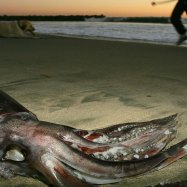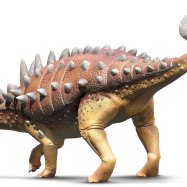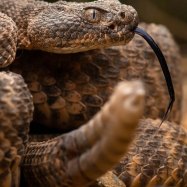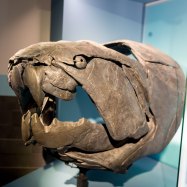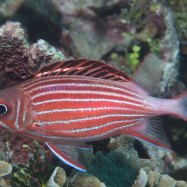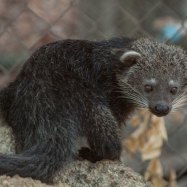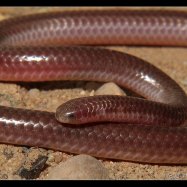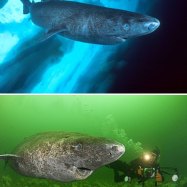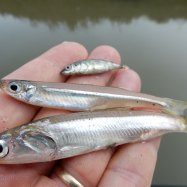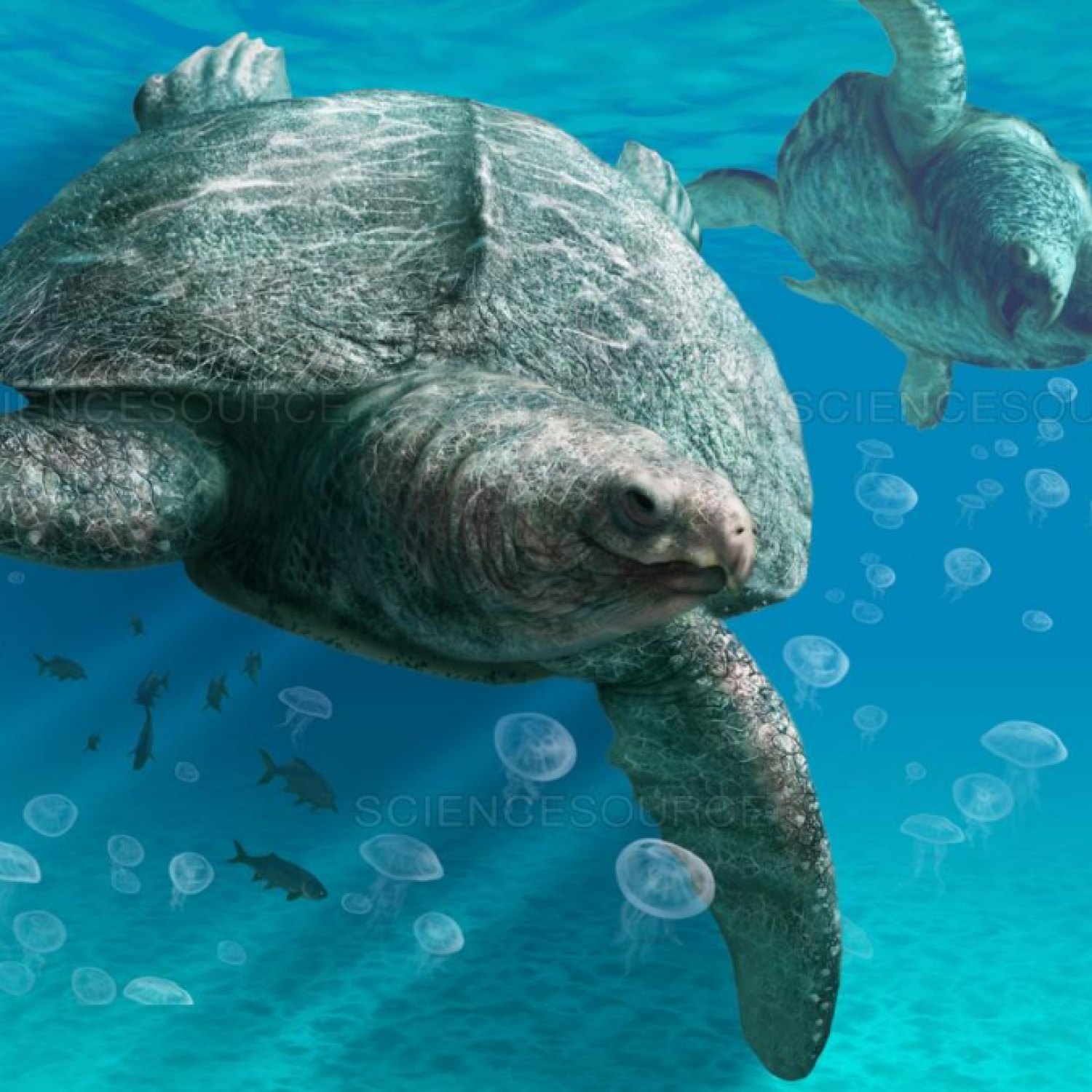
Archelon Turtle
4.5 to 5 meters
The Archelon turtle, found in the Western Interior Seaway, was a massive sea turtle that roamed the oceans during the Cretaceous period. With a length of 4.5 to 5 meters, it is the largest known turtle species. Its flattened body shape allowed it to swim with ease, making it a top predator in its habitat. Its scientific name, Protostegidae, translates to first roofed turtle, showcasing its evolutionary significance. #Archelon #turtle #prehistoricanimals #Cretaceousperiod #marinepredator #extinctspecies.
Animal Details Summary:
Common Name: Archelon Turtle
Kingdom: Animalia
Habitat: Marine
Archelon Turtle: The Colossal Marine Reptile from the Western Interior Seaway of North America
Hidden beneath the vast expanse of the Western Interior Seaway, about 75 million years ago, lived a creature that could only be described as gigantic. The Archelon Turtle, or Archelon ischyros, was an enormous marine reptile that roamed the waters of present-day North America. With a length of 4.5 to 5 meters, this colossal creature was not only the largest turtle to have ever existed, but it was also one of the largest marine reptiles of all time Archelon Turtle.Ancient Origins
The Archelon Turtle belongs to the kingdom Animalia, phylum Chordata, and class Reptilia. Its scientific name, Archelon ischyros, is derived from the Greek words "arche" meaning "original" and "eleon" meaning "turtle." Fittingly, this ancient creature is indeed considered the original turtle, as it is the earliest and most primitive member of the superfamily Chelonioidea, which includes all modern sea turtles.This magnificent creature was first discovered in 1895 by American paleontologist Samuel Wendell Williston. The remains of the Archelon Turtle were found in the Pierre Shale Formation of the Western Interior Seaway, a shallow sea that covered much of the present-day central United States during the Late Cretaceous period. Since then, numerous fossilized remains of this giant turtle have been found in various locations across North America, providing researchers with valuable information about its physical features and way of life.
Family Ties
The Archelon Turtle belongs to the family Protostegidae, a group of marine reptiles that flourished during the Mesozoic Era. This family also includes other large sea turtles such as Desmatochelys, Protostega, and Eochelone. Protostegids are believed to have evolved from land-dwelling turtles but adapted to living in the water as they developed a flattened body shape and flipper-like limbs Antelope.Habitat and Distribution
As a marine reptile, the Archelon Turtle spent its entire life in the ocean. It inhabited the shallow, warm waters of the Western Interior Seaway, a vast inland sea that stretched from the Gulf of Mexico to the Arctic Ocean. This ancient sea was estimated to be about 1600 kilometers wide and 200 meters deep, making it an ideal habitat for marine creatures such as the Archelon Turtle.The Western Interior Seaway covered a large portion of North America, including present-day states such as Kansas, South Dakota, Colorado, Montana, and Texas. This means that the Archelon Turtle had a widespread distribution, making it a common sight in these waters during the Late Cretaceous period. However, it is believed that this species was only found in North America and did not exist in any other part of the world.
Diet and Feeding Method
Being a carnivore, the Archelon Turtle was a fierce predator that fed on a variety of sea creatures. Its diet would have consisted mainly of ammonites, marine reptiles, fish, and possibly even small sharks. These creatures were easily accessible in the shallow waters of the Western Interior Seaway, making it an ideal feeding ground for the Archelon Turtle.This ancient marine reptile used its powerful jaws and sharp beak to hunt and feed on its prey. Its strong neck muscles and flattened body shape allowed it to swiftly move through the water, making it a quick and agile hunter. The Archelon Turtle's feeding method was an important part of its survival, as it needed to consume a large amount of food to sustain its massive size.
Distinctive Physical Features
The Archelon Turtle is best known for its impressive size, but it also has several other unique physical features that set it apart from other ancient marine reptiles. Its body was covered in dark green to brown-colored skin, which blended in with the murky waters of the Western Interior Seaway, giving it a perfect camouflage against potential predators.One of the most distinctive features of the Archelon Turtle was its enormous shell, or carapace. Measuring up to 4 meters in length, this massive shell provided the necessary protection for the turtle's vital organs while also giving it the buoyancy needed to swim in the open ocean. The shell was divided into several plates, making it flexible for the turtle to move and swim freely.
Adapted to the Ocean
As a reptile, the Archelon Turtle had to adapt to living in the water to survive. Its flattened body shape allowed it to glide effortlessly through the ocean, and its front flippers had evolved into powerful paddles, enabling it to swim at great speeds. Its hind limbs had also transformed into flippers, which were used for steering and stability in the water.Additionally, the bones in the Archelon Turtle's body were solid, unlike those of most modern turtles which have hollow bones. This adaptation was crucial for deep-sea diving, as it allowed the turtle to dive down to the ocean floor to hunt for food. With its strong, streamlined body and flipper-like limbs, the Archelon Turtle was perfectly suited for life in the ocean.
A Vulnerable Species
Despite its impressive size and strength, the Archelon Turtle was not invincible. Like many other ancient marine animals, this species faced numerous threats from predators, diseases, and environmental changes. The Western Interior Seaway, with its shallow and calm waters, was ideal for hunting small prey, but it was also an easy target for larger predators.Unfortunately, the Archelon Turtle, along with many other species that inhabited the Western Interior Seaway, became extinct at the end of the Cretaceous period, about 65 million years ago. The cause of their extinction is still a topic of debate among scientists, with various factors such as climate change, asteroid impacts, and volcanic activity being proposed as possible reasons.
In Conclusion
The Archelon Turtle may have disappeared from the oceans millions of years ago, but its legacy lives on through the numerous fossilized remains that have been discovered. Through these fossils, we have been able to learn a great deal about this colossal marine reptile, including its physical features, habitat, and way of life. It is truly a remarkable creature that played an important role in the ancient ecosystem of the Western Interior Seaway, and its story continues to fascinate and intrigue us to this day.

Archelon Turtle
Animal Details Archelon Turtle - Scientific Name: Archelon ischyros
- Category: Animals A
- Scientific Name: Archelon ischyros
- Common Name: Archelon Turtle
- Kingdom: Animalia
- Phylum: Chordata
- Class: Reptilia
- Order: Testudines
- Family: Protostegidae
- Habitat: Marine
- Feeding Method: Carnivorous
- Geographical Distribution: North America
- Country of Origin: United States
- Location: Western Interior Seaway
- Animal Coloration: Dark green to brown
- Body Shape: Flattened
- Length: 4.5 to 5 meters
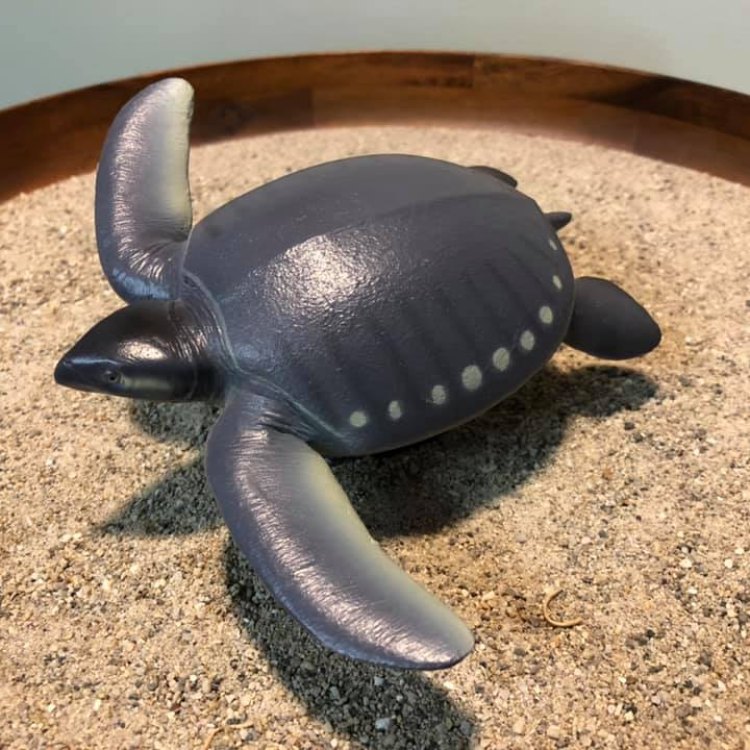
Archelon Turtle
- Adult Size: Large
- Average Lifespan: Unknown
- Reproduction: Sexual
- Reproductive Behavior: Nesting
- Sound or Call: Unknown
- Migration Pattern: Unknown
- Social Groups: Unknown
- Behavior: Unknown
- Threats: Habitat loss, pollution, climate change
- Conservation Status: Extinct
- Impact on Ecosystem: Unknown
- Human Use: None
- Distinctive Features: Large size, flat body, and flipper-like limbs
- Interesting Facts: Archelon is the largest known sea turtle
- Predator: Unknown
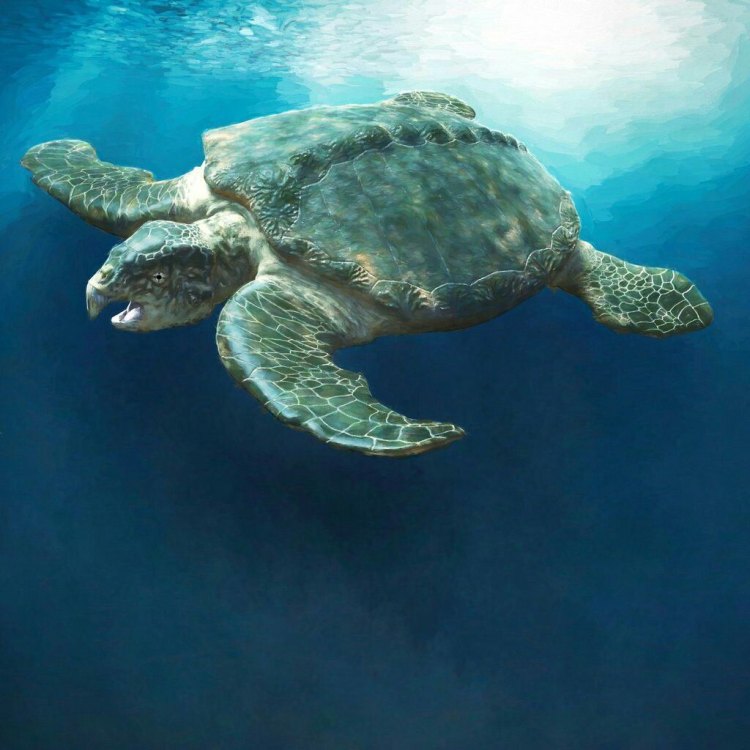
Archelon ischyros
The Magnificent Archelon Turtle: A Lost Giant of the Sea
The sea is home to many fascinating creatures, but few can compare to the impressive Archelon turtle. At an adult size of up to 15 feet and weighing up to 2,200 pounds, this gentle giant was the largest known sea turtle to have ever lived. However, despite its impressive size and unique features, the Archelon turtle is now extinct, leaving only its fossils to tell its story.Adult Size:
The Archelon turtle was a true titan of the ocean PeaceOfAnimals.Com. Reaching lengths of up to 15 feet and weighing up to 2,200 pounds, it was the largest sea turtle ever recorded. This size is even more impressive when you consider that the average size of modern-day sea turtles is between 3 and 5 feet. The Archelon's sheer size and weight made it an awe-inspiring sight to behold and a formidable inhabitant of the ancient seas.
Average Lifespan:
While the average lifespan of the Archelon turtle is unknown, it is believed that they could have lived for several decades, similar to modern-day sea turtles. It is likely that they reached sexual maturity around 25 years old, and the females would have then returned to their nesting grounds every few years to lay their eggs.
Reproduction:
Like most sea turtles, the Archelon's reproductive method was sexual. The females would lay their eggs on the beaches of the ancient oceans, digging deep nests in the sand to protect their eggs from predators. It is estimated that each female could lay up to 6 sets of eggs in a single breeding season, with each set containing around 100 eggs.
Reproductive Behavior:
Unfortunately, due to the lack of information available on the Archelon turtle, their reproductive behavior remains a mystery Asian Vine Snake. However, scientists believe that they may have displayed similar nesting behaviors to modern-day sea turtles, such as returning to the same beaches year after year and using the Earth's magnetic field to navigate back to their nesting grounds.
Sound or Call:
It's unknown whether the Archelon turtle produced any specific sounds or calls. However, as air-breathing animals, they would have had the ability to vocalize, potentially using it for communication during mating or nesting season.
Migration Pattern:
The migration patterns of the Archelon turtle are also unknown. It is possible that they migrated to different areas to feed and find mates, similar to modern-day sea turtles. However, as they were such massive creatures, they may have found enough resources in their local habitat, reducing the need for extensive migration.
Social Groups:
As solitary creatures, it is believed that the Archelon turtle did not form social groups. However, during nesting season, females may have shared the same beach or nesting area, leading to brief interactions with other individuals.
Behavior:
Unfortunately, little is known about the behavior of the Archelon turtle. However, it is believed that they were relatively calm and gentle animals, spending most of their time slowly gliding through the ancient seas in search of food.
Threats:
As with many species, humans have played a significant role in the extinction of the Archelon turtle. However, it's important to note that the exact cause of their extinction is unknown. Some scientists believe that the rise of the dinosaurs could have played a role in their decline, while others theorize that changes in the Earth's climate and sea levels may have also contributed. However, human activities, such as habitat loss, pollution, and climate change, may have accelerated their demise.
Conservation Status:
Today, the Archelon turtle is classified as extinct, with no known living individuals. While this may seem like a sad end for such a magnificent creature, it's worth noting that extinction is a natural part of the cycle of life. Many species have gone extinct throughout Earth's history, and the Archelon is just one of them. However, its story serves as a reminder of how human actions can cause harm to the delicate balance of our planet's ecosystems.
Impact on Ecosystem:
The Archelon turtle, with its large size and slow-moving nature, likely played a crucial role in its ancient ecosystem. They would have grazed on plants and sea grasses, helping to maintain the balance of the ocean's food web. Their nesting habits also would have contributed to the health of the beaches where they laid their eggs, providing vital nutrients to the surrounding land.
Human Use:
Unlike many other sea turtles, the Archelon had no known human use. This could be due to their sheer size, which would have made it difficult for humans to hunt or catch them for consumption.
Distinctive Features:
The Archelon turtle was a unique and remarkable creature, with many distinctive features that set it apart from other sea turtles. Its large size and flat body were its most noticeable physical features, giving it a unique and imposing appearance. Its flipper-like limbs and massive head also helped to distinguish it from other species of sea turtles.
Interesting Facts:
The Archelon turtle's most remarkable and widely-known characteristic is its enormous size. But did you know that they were also one of the largest turtles ever to live on Earth? Many of their fossils have also been uncovered in the Midwest region of the United States, far from the sea, indicating that they may have been migratory animals that traveled a vast distance to nest on the beaches of the ancient seas.
Predator:
The predators of the Archelon turtle are unknown. However, due to their size and thick, bony shell, they were likely not an easy target for other marine predators. It is possible that they may have faced danger from larger predators such as the ancient great white shark.
In conclusion, the Archelon turtle was a magnificent and awe-inspiring creature that roamed the ancient seas. Its size, unique features, and role in the ecosystem make it a valuable addition to the planet's biodiversity. While it may be extinct now, its legacy lives on, reminding us of the importance of preserving our planet's delicate natural balance and the precious species that call it home.

Archelon Turtle: The Colossal Marine Reptile from the Western Interior Seaway of North America
Disclaimer: The content provided is for informational purposes only. We cannot guarantee the accuracy of the information on this page 100%. All information provided here may change without prior notice.


